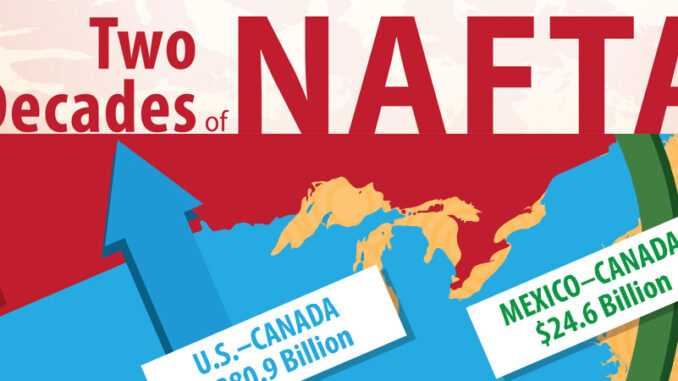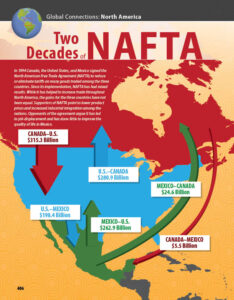

The North American Free Trade Agreement (NAFTA) is a treaty (like a formal contract) that was signed into law by the leaders of the United States, Mexico and Canada in 1994. It was created to increase trade between the three North American nations by lowering (and finally eliminating) trade barriers. Those barriers were mostly duty and tariffs, which are like taxes on goods that are transported across a county’s borders. The goal was for all three countries to benefit from being able to buy and sell less expensive products.
The agreement was a controversial one from the start. It was highly debated and only narrowly passed in both the House of Representatives and the Senate during Bill Clinton’s presidential administration. Those in favor of the agreement believed that less expensive goods would positively impact Canada, the United States, and Mexico. Those who opposed NAFTA believed that the United States in particular would lose jobs to Mexico, because the labor costs in Mexico were cheaper and because some business regulations (such as environmental laws) are much less strict on Mexican industry.
History

(Click the image for a larger view.)
Before NAFTA was passed, Mexico, Canada and the United States had to pay large tariffs (up to 12%) on goods made in each of the other two countries. This meant they had to charge more to their customers in order to make a profit. When the agreement was passed, these extra costs were eliminated. Companies could sell products cheaper, encouraging consumers to buy more.
This led the companies to hire more workers. Negotiations to gradually eliminate the trade barriers began during the presidency of George H.W. Bush. When Bill Clinton took office, he added protections for workers before it went before Congress for a vote.
Advantages
During the two decades of NAFTA’s operation, all three countries have seen an increase in trade. At its peak, NAFTA was responsible for a total increase in trade from $297 billion in 1994 to $1.6 trillion in 2009. The 2009 high point began to decline due to the financial crisis that hit the United States at that time.
Certain industries have benefited greatly from NAFTA. Agriculture is one of the most successful. Mexico is the top export destination for beef, rice, bean, apples soybeans and corn sweetener grown in the United States. Health care, financial services and oil production also benefited from NAFTA. Production of Mexican goods, especially automotive products and electronics, has increased by 435%. Canada has also experienced significant economic growth from automotive production, oil exports, and also increased shipment of beef, as well as wood and paper products. In the United States, the industries benefitting the most from NAFTA have been transportation, appliance makers and energy corporations.
Disadvantages
The manufacturing industry was greatly impacted by NAFTA. The U.S. lost nearly 700,000 jobs when production plants for items like automobiles, appliances and textiles (woven materials like wool, silk or cotton) relocated to either Mexico or overseas. The economies of some smaller cities in the United States were deeply affected by the outsources of manufacturing jobs to other countries. The factories set up in Mexico are largely along the U.S. border, that have become overpopulated slums. Mexican farmers suffered due to U.S. subsidized products. Mexico’s environment has been negatively impacted because the environmental laws are considerably less strict, leading to more pollution and damage to the landscape. Canada also lost jobs to outsourcing. Some economists believe Canada’s economy has become too closely tied to the United States.
Related Links
- Learn more about NAFTA and Global Connections in McGraw-Hill Education’s Geography: The Human and Physical World, coming soon!
